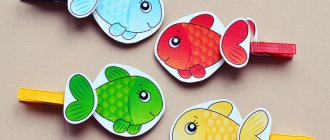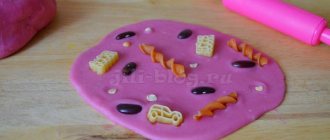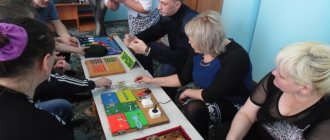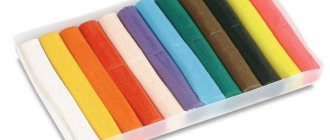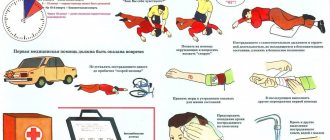Homemade toys for children with your own hands can be found in any nursery. It is more interesting and easier for parents to make an educational toy themselves than to look for something suitable in stores. Didactic games are very useful; this form of active learning is applicable from a very early age and has many varieties aimed at developing fine motor skills, speech, and logic.
Development of fine motor skills by age
Do-it-yourself toys for fine motor skills are in first place in popularity . Games that develop this type of coordination of movements are very useful for the development of a child’s speech. There are several convenient and simple options for making them yourself.
Such homemade toys are suitable for the development of a child from 3 to 12 months. The first option is a magic glove. Required:
- an old thread glove of an adult;
- thread and needle;
- beads of various shapes and sizes, bells, beads.
Sew small details onto a clean, washed glove. Sew beads thickly onto the fingertips - then the glove can also be used for massage. Sew beads of different sizes onto your palm. The glove is sheathed on both sides.
The adult puts a ready-made glove on his hand and invites the baby to touch it - fingering the colorful elements, looking at them and touching them. This stimulates acupuncture points on the fingertips and palms, stimulates blood circulation and promotes the proper development of the child.
After a year, a sensory mat, a DIY educational panel, and travel toys of a similar design would be appropriate for the nursery.
Developmental mat for fingers
For such a rug you will need:
- felt 10 colors;
- thick fabric for the base;
- buttons of different shapes - stars, dolphins, cars, butterflies, flowers, etc.;
- needle, thread;
- sewing machine, tailor's pins;
- ruler and tailor's chalk;
- braid and appliqués.
Work order:
- Cut 10 rectangles measuring 10 by 15 cm from felt. Sew buttons and appliqués onto each rectangle. Do this in such a way that the path of buttons leads to the sewn picture. Add strips of braid to each piece.
- Distribute the felt on a sheet of base, pin together with tailor's pins and sew on a machine.
Making a busy board
Literally translated from English, this word translates as “busy board” . This is truly a fun educational stand for a boy that anyone can make with their own hands. The main task of such a craft is not only to develop the child’s motor skills, but also to distract him from real objects that may be unsafe in everyday life.
As a base, a piece of plywood is usually taken, onto which a variety of parts are screwed or glued with liquid nails. The development panel itself is usually mounted on the wall. It may contain:
- socket and plug;
- disk from an old landline phone;
- calculator, old TV remote control;
- latch;
- the padlock;
- computer cooler;
- latches and hooks of all kinds;
- any rotating household mechanisms - like on a stove, a window, a window;
- switches and toggle switches;
- dials with and without arrows;
- bell, beep and other “loud” parts;
- bells and bells;
- rotary and ball valves;
- furniture wheels.
Educational mats
Necessary for babies up to one year old. They are a canvas with many objects. The baby learns to roll over, reach for bells and mirrors, touch them, bite them, and pull them towards him. New tactile sensations develop the desire to explore the world, coordination of movements, and fine motor skills.
You don’t have to buy an educational mat; you can make it yourself from thick fabric and household items. Handmade, of course, will take a lot of time, but you will definitely be confident in the safety and environmental friendliness of the toy.
Sensory games and toys
Modern life is designed in such a way that people spend quite a lot of time in transport . Regardless of whether your child is riding in the car seat of the family car, or on the bus on his mother's lap, it is worth providing him with an interesting activity. Otherwise, the child will find it for himself.
Fish on clasps
You can sew a fish with clasps for your baby’s entertainment and development with your own hands. To work you will need:
- two types of fabric;
- cardboard, pencil, ruler, scissors;
- cereal as a filler (the specific choice of cereal is yours, but they must first be calcined in the oven);
- fasteners of the following types: Velcro tapes, 2 buttons, 2 buttons, carabiner, zipper;
- sewing machine and sewing accessories;
- felt black and white.
DIY toys
Toys for developing and improving fine motor skills can be made from improvised means and unnecessary items at home.
Board
Busy board is an innovation among educational toys. It is a small piece of MDF, chipboard, with locks attached to them, dials from old telephones, bells, switches and other small parts that are interesting to touch and unscrew.
The stand for developing fine motor skills is so captivating for infants that they explore it for several hours a day.
Important! Do not attach sharp objects or glass fragments to the board. They can hurt the baby.
Soft cube
Suitable for babies from 6 months of age. It is sewn from pieces of multi-colored fabric and decorated with appliqués. You can embroider letters and numbers on them. Pyramids and houses are made from soft cubes; they can be thrown and crushed.
Soft books play the same role. They can be made from fabric, appliques in the form of fairy-tale characters.
Bags of cereals
Sew a fabric bag from a dense, pleasant-to-touch material. The size of the toy should correspond to the age of the baby. For one-year-old babies - 6x6 cm, for older children from 10 cm in width, 8-10 cm in length.
Sew it on three sides, leaving the fourth open. Fill the bag with any cereal: rice, buckwheat, beans. Fingering toys is a fun pastime for all kids.
Important! Periodically check the quality of the seams, make sure that the filler does not spill out and that beans do not get into the babies’ mouths.
Happy snake
Make a rope out of fabric, or sew the material together in several layers in the form of a sausage. Attach many buttons of different sizes, shapes, and textures to it with a thread. The kids sort them out, feel them, trying to pick them off. This is how hand strength and finger motor skills develop.
Knitted toys
Suitable for infants and children up to 3 years old. Mothers knit toys in the form of animals and dolls. You can put clothes on them, make eyes out of buttons for them. Use threads of different colors and textures. It is important for the baby to feel the heterogeneity of the material.
Books
This is a whole didactic complex. The number of pages depends on the imagination, patience and hard work of the parents. To create it you will need pieces of A4 size fabric, padding polyester, pieces of multi-colored material, buttons, zippers and everything you can find for creativity at home.
You can create entire compositions on the pages of the book to develop fine motor skills. For example, figures of animals, fish, on others - create landscapes, stick on applications of numbers and letters. Nothing limits mom's imagination.
It is important to understand the purpose of creating such a manual for the development of motor skills. Glue laces with beads, zippers, and ribbon loops onto the page of the book. You can use buttons and Velcro to unfasten elements so that the baby can attach them himself during play, developing motor skills and learning self-service at the same time.
Didactic classes
Such games are an excellent tool not only for workers in the field of preschool education, but also for young mothers who want to spend quality time with their children. Games with bottle caps are distinguished by their simplicity and excitement at the same time. Children learn to create something meaningful and interesting with the help of ordinary objects that have little connection with each other in everyday life.
Laces
These are book toys, cardboard figures or a set of objects that can be tied together with a cord. While playing, kids develop motor skills, logic, thinking, attention, and coordination.
Laces are made of cardboard and wood. Small holes are made in objects through which a thick thread is threaded. The order of action is not important at first. The main thing is that the child learns to put the lace into the hole, and then connect several objects on one thread.
Speech therapy games
Educational games and crafts to stimulate fine motor skills help develop speech. However, in addition to such games and activities, there are special speech therapy games that form correct breathing in children.
Games for developing air flow
When the goal is to develop a child’s speech, it is important to teach him proper breathing, which affects the pronunciation of sounds, articulation and voice development. Two simple but interesting crafts for children will help with this .
Fireworks game
To create you will need:
- plastic bottle;
- foil confetti;
- cocktail tubes.
Confetti is poured inside the bottle. Several holes are made in the plastic of the bottle - 3 or 4, depending on the size of the container, and straws are inserted into them. Children should use a long exhalation to lift the confetti into the air. One hole should be free.
Sorters
The purpose of the game with a developmental sorter is to teach the baby to think. The child has to include analysis, memory, knowledge about the color, shape, and size of objects.
The sorter is a platform of different types. This could be a house, columns, frames, cubes. Small objects are strung on them and placed inside through holes of various shapes. The child sorts the molds, putting them in the right places.
Sorters are intended for the development of fine motor skills of children from 6 months to 2-4 years. For children under one year old, these are simple platforms, for example, pyramids, musical pots with holes on the sides. Playing with a sorter requires infants and older children to perform precise actions. This is the only way to achieve the desired result.
Wooden sorting toys are popular today. They are safe and easy to make at home. You will need a small elongated board, sticks and elements of different shapes cut out of plywood. Color the triangles, squares, circles in different colors. Cut holes in them and your child will string them onto the platform.
Pusher
In a few minutes, an ordinary mayonnaise jar with a lid or container can turn into a simple simulator for fine motor skills. Also prepare an awl or knife and small objects for pushing.
Make holes in the lid of the existing container that correspond to the size of the beads (beans, tennis balls, counting sticks, coins). For some items, you can make the holes a little smaller so that the little one has to make an effort. This way he will become familiar with the concepts of “big and small”.
Alternatively, you can use a sippy cup and push pompoms or buttons into it. The main thing is to always be close to the baby while playing so that he doesn’t accidentally swallow a bead or button.
"Hungry Box"
We cover a small box with colored paper and draw a funny face on the lid. In the place where the mouth is located, cut a hole. We invite the baby to “feed” the box with small objects.
Baby sling beads and bracelets for babies
These toys are more suitable for babies to chew and feel. You can’t always trust the assortment in stores; there is no guarantee of the safety of the products. And at home you can make them yourself using step-by-step instructions.
These are the earliest toys that look like beads or bracelets. Mothers often wear them to distract the baby while he is in a sling or in his arms.
Important! This will require crocheting skills. The ability to tie objects (bracelets, beads) and knit individual elements (animal figures, soft balls).
What you will need:
- wood beads;
- cotton threads;
- hooks;
- waxed cord/ribbon (base);
- filler (silicone fiber, cotton wool);
- rustling or any rattling objects (if necessary).
Operating procedure:
Decide in advance whether it will be a small bracelet, full-fledged beads or a biting toy. The base is a wooden object.
Bracelet - toy
Option 1. Take a small wooden ring and carefully tie it so that the knitted fabric covers the entire surface. In a similar way, tie a small wooden bead - the “head” of the toy. Separately tie a pair of ears to it, decorate the muzzle. When finished, connect the parts.
Option 2. Here wooden balls alternate with soft, knitted ones. You can tie several wooden balls - beads or tie balls, stuffing them with cotton wool/foam rubber. Let soft balls alternate with ordinary wooden ones in the bracelet. Connect them by using a thick, cotton thread.
Option 3. A bracelet with different balls is complemented by a pair of wooden rings.
Option 4. Bracelet - hippo. Tie a wooden base bracelet with cotton thread, just tighter and secure the ends. Tie the 4 legs and head of the hippopotamus separately. Fill them with cotton wool or other soft filler.
Option 5. Multi-colored knitted balls are collected together, with a figurine of a small hippopotamus. Tie each ball separately. You can use multi-colored threads to make the toy brighter. When collecting ready-made balls, alternate them with small beads. Sew a knitted animal figurine in the center.
INTERESTING: How to sew an educational book with your own hands
Sling beads are made in a similar way, only they are larger. Mom wears such a practical aid for the baby, at the same time a distracting thing.
Such toys are also suitable for one-year-old children, 1-2, even 1-3 years old. Over time, you can complicate the structure of the beads or bracelet by explaining to your child exactly what elements it consists of.
Interactive handmade toys - a way to early develop motor skills in children
Educational toys are smart teachers, reliable helpers and caring educators rolled into one. They provide easy, unobtrusive education and all-round development of the child. Handmade toys are now mega-popular primarily because of their undeniable benefits, as well as aesthetic beauty and uniqueness.
Parents who care about the comprehensive development of their beloved baby and take part in their upbringing should try their hand at simple needlework. Many mothers, even during pregnancy, begin to prepare for future interactive games with their child. It is not difficult to make bags with your own hands, which in the future will play an important role in the development of the active muscles of the baby’s fingers. If the mother is a craftswoman, then even before the baby arrives, the children’s room can be decorated with a hand-made interactive book, which will be indispensable for the baby’s progressive learning by activating fine motor skills.
Caring and loving parents know that what is created with love will definitely be useful. And if this is an interactive toy that will help them raise smart people and smart girls, then they will not spare any effort or time to create it.
Precautionary measures
There are many master classes that help children of all ages make toys at home. Many modern parents try to develop their child’s motor skills early, while he is still an infant. Kids are always interested in new things.
However, when choosing materials and step-by-step instructions, it is worth remembering the following precautions:
- Sew all the elements of the toy tightly, especially small ones - children not only love to touch, but also try out the item they like.
- After finishing the craft, check all its elements yourself, several times. How tightly are the buttons sewn on? Is it easy to unzip? Are there tight spots where you could accidentally get your finger caught?
- Examine the toy. Remember, there should not be any small sharp ends, cutting edges or other dangerous elements that could injure the baby.
- Use only natural materials that do not contain any impurities or chemicals for toys to develop hand motor skills for children.
- Use your imagination. Children 0-3 years old and older learn about the world through tactile sensations. That's why they try to touch everything, even taste it. Make different toys - soft and hard, rough. Experiment with sizes and shapes. Remember, even a one-month-old baby can develop by learning new subjects.
Sensory pads
These are fabric bags filled with cereal or beads; they are easy to make. You can sew such accessories in the shape of animals or figures.
But the best option is the so-called little glasses, which have a transparent window. In addition to cereals and beads, such toys contain “treasures” (small figures, sorter parts, etc.). Children move their fingers through the bag and look for hidden objects.
Toys made from lids
Little children are big fans of unscrewing bottle caps. It turns out that this is an incredibly useful activity for practicing motor skills!
In order to make an educational toy, you will need: a shoe box, cut off bottle necks with caps, colored paper.
Carefully cut holes in the lid. We insert parts of the bottle into them so that the necks remain inside the box and the caps remain outside. We decorate everything with colored paper.
Use your imagination or use our sample.
If you thread strings through the lids and secure them, they will not get lost during the game.
Mosaic
Materials: plastic lids, balloon holders, box and glue.
We glue the “holders” and plugs together so that we get chips on the legs. We use an awl to make holes in the top of the box. We get an excellent educational mosaic with large details that definitely won’t fit into the baby’s mouth! And interesting games will turn arranging chips into an exciting activity:
- "Track". Place two toys on the field and ask your baby to help them meet by connecting them with a path.
- "Stars in the sky." Prepare a figurine of a bunny and tell your little one a fairy tale: “The bunny got lost in the dark forest and won’t find his way home. We will help him if we light stars in the sky.” Lay out the yellow parts, and then let the morning come and the sun “rise.”
- "Hen and Chicks." Lay out with white counters the figure of a mother hen calling her children: “Chick-chick, my chickens!” Invite your child to arrange the chicks.

